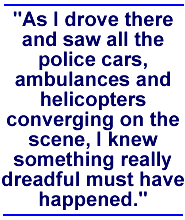
By Larry Zalin
He'd arrived at the scene of many tragedies before, but nothing prepared George Kochaniec Jr. for what he saw after he raced to Columbine High School on April 20, 1999.
"I knew that there'd been a shooting at the school, but I had no idea of the extent of it," Kochaniec says. "As I drove there and saw all the police cars, ambulances and helicopters converging on the scene, I knew something really dreadful must have happened."

The veteran news photographer for the Denver Rocky Mountain News stationed himself in an area where wounded students were being triaged by emergency medical staff. Soon there were more than a dozen wounded students awaiting medical attention.
"I kept my distance from the injured kids by using a 500mm lens," Kochaniec explains. "I'd never been in a situation like that, and I didn't want to make it any worse for those kids."
Kochaniec and his Denver Rocky Mountain News colleagues received the Pulitzer Prize in spot news photography last year for their photographs of Columbine. Yet more than a year after the tragedy, Kochaniec, the father of two high-school boys himself, is still sometimes bothered by what he experienced that day. "Little things trigger memories," he says. "Sometimes I think I just can't move on."

UW Professor Roger Simpson directs the Dart Center for Journalism and Trauma.
Kochaniec is not unique in his reaction to the tragedy at Columbine. Reporters and photographers who have covered violent events say that afterward they feel sadness, exhaustion, guilt, apprehension and fear for family members and themselves, according to a recent study by UW Communications Professor Roger Simpson, a former reporter, and James C. Boggs, a UW doctoral student. Nearly three-quarters of all reporters surveyed acknowledge symptoms of stress after covering a traumatic event.
"The eye opener was in realizing how vulnerable reporters are," Simpson explains. "Journalists carry around a lot of emotional baggage, some of it going back decades and decades after being out in the field covering car crashes, fires and suicides."
Go To: Page 1 | Page 2 | Page 3 | Page 4
- Sidebar: Living—and Dying—with the Media
- Return to March 2001 Table of Contents